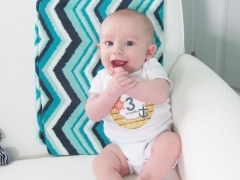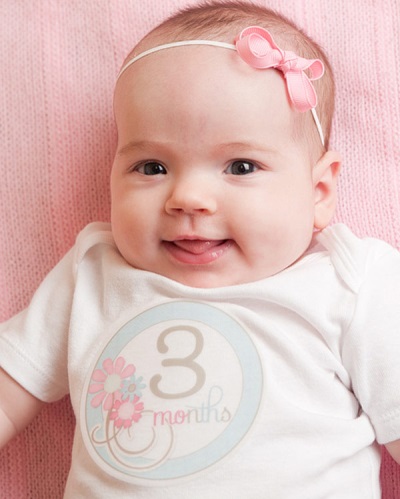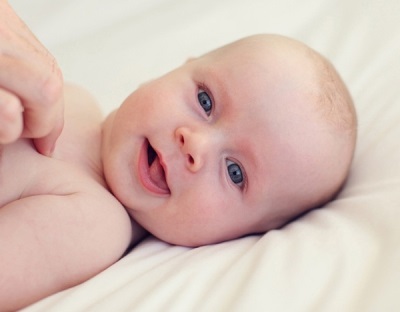Child development at 3 months
In the first year, the baby develops rapidly at a fast pace, delighting parents with new skills every month. The three-month old horned boy changes visually and emotionally. Let's find out what kind of new skills a crumb gets at this age and how parents can help the toddler to develop.
Physiological changes
- Child's subcutaneous adipose tissue develops, therefore, by the age of three months, the crumbs appear puffy cheeks, as well as folds on the legs.
- Muscle system karapuz develops from top to bottom. Scarce has already mastered the retention of the head and began to own their hands. The hypertonus of the handles is already completely gone, which allows the baby to more actively examine his body and toys, touching everything with his hands.
- Many reflexes of newborns are already dying out. For example, the search reflex (turning the head when stroking at the corner of the mouth), the proboscis reflex (stretching the lips when touching them), and the Babkin reflex (opening the mouth with pressure on the palm) should not be present in a three-month baby. The same reflexes as crawling, sucking or Moreau, at 3 months are still very pronounced.
- The digestive system of the baby is developing. The stomach increases its capacity and can hold more milk already, but the child is not ready to accept any other food other than breast milk or an adapted mixture. The only addition to the infant diet can be supplemental vitamin D, which is often prescribed to 3-month-old children as a prophylactic against rickets.
- The chair of a three-month baby is more uniform and regular. In receiving only breast milk, the frequency of stool is from 1 time in 2-5 days to 5 times a day. If the child did not have a stool exclusively for breastfeeding for several days, the child behaves normally and the chair is soft after such a long pause, no additional stimulation is required for the child’s feces.
For information on how to play with a three-month baby, see the following video with O. N. Teplyakova, an expert on intellectual development.
Physical development
On average, during the third month of life, an infant increases its weight by 750-800 grams, and its growth becomes 2.5 centimeters more than it was in 2 months. The increase in the head circumference occurs by about 1 cm, and the chest circumference - by 1-1.5 cm (by the age of four months, these two parameters become the same).
Height, body weight and other indicators of the physical development of the child are determined by many factors - heredity, the presence of diseases, the type of feeding, and others.
Medics have determined averages, as well as the limits of the norm by which parents can determine whether their three-month-old baby develops normally. They are presented in the table:
Indicator | The average value of 3 months | Boys in 3-4 months | Girls in 3-4 months |
Weight | 5800-6400 g | 5000-8000 g | 4500-7500 g |
Growth | 59.8-61.4 cm | 57.3-65.5 cm | 55.6-64 cm |
Head circumference | 39.5-40.5 cm | 38.1-42.9 cm | 37.1-42 cm |
Chest circumference | 38.9-39.5 cm | 36.5-41.6 cm | 37.3-41.4 cm |
What baby can?
- Lying on his stomach and in an upright position, the baby has already learned to hold his head. If you support the baby in a vertical position under the arms and put it on a solid surface, the child will be leaning with his feet. In addition, lying on his back, the crumb has already learned to turn on the flank.
- Vision crumbs actively developed. The kid for a long time examines objects around, paying attention to both stationary and rapidly moving objects. To better see everything in a pose lying on the tummy, the crumb is lifted on the forearms.
- The sounds of a three-month-old baby have become more diverse. Consonants are added to vowels. Being in a good mood, the baby is walking for a long time.
- A child at 3 months is very emotional. The baby is very happy about the appearance of mother and communication with her. The complex of revival also arises when an adult sings, sounds of musical instruments and a form of toys. If the crumb is dissatisfied with something, you will hear a loud cry. Negative emotions occur in a 3-month-old baby, when communication with the mother stops, the toy suddenly disappears, the surrounding temperature changes, there is a restriction of movement or pain.
- By three months, the baby begins to more actively explore the world, sucking everything that can take pens. First of all, the baby sucks its cams or fingers.
Classes for development
Now the baby is awake longer than in the first two months of life, and the time when the baby is ready to accept new information and communicate, you need to use it thoughtfully.
- In the morning, do some small exercises with the baby. Gently bend and unbend the legs and arms to improve the condition of the ligaments. You can also practice with the baby on fitball - when laying the child on the ball on the tummy or on the back, hold the child by the legs and roll gently.
- Regularly massage the entire body of the baby, as it will stimulate the muscles of the crumbs and other organs, as well as improve the health of the crumbs. Start by patting the back and neck, and at the end of the massage, easily knead the joints of your knees and elbows.
- To the daily gymnastics, which the mother performs with the baby, at 3 months of age it is worth adding exercises that will prepare the baby for coups. Turn the right foot of the baby lying on the back so that it becomes slung over the body. It is this movement that is given to the children most difficultly and it gives the impetus for a coup.
- To stimulate the ability to raise the head and shoulders in a prone position on the stomach (when the baby is resting on the forearm), spread the child on the stomach more often while simultaneously laying around bright toys around the baby. For this purpose, special educational mats.
- Put rattles in the hands of the child so that the baby will learn to hold the toys on its own and study them. Also hang soft toys above the baby’s crib so that the baby can reach them with their hands. It would be great if inside such toys there are bells and after hitting them the peanut will hear ringing sounds.
- Sing the baby songs, and also talk to the baby more often. In the conversation it is worth making small pauses, giving the toddler the opportunity to “respond” to you with his own voice. Often call the baby by name, and also accompany with explanations any of your actions.
- Show your child his reflection in the mirror. It is also worth introducing the baby with images of animals and various objects.
- To stimulate the tactile sensitivity, let the baby feel items with different textures, for example, a ball twisted from threads, a kitchen tack, a teddy bear, a soft cube with a bell inside.
- Include your child's music of different styles. When the baby is awake, turn on something rhythmic and fun, and before going to sleep you should listen to some calm melodies with the baby. Listening to rhythmic music with your child, clap your hands to the beat.
- If you have a pet, watch him with your baby. Also show little animals during the walk.
- While swimming, throw some bright balls or rubber toys into the water. Let the crumb try to catch them in the water.
Rings will make the massage more fun.
See the next exercise by Tatiana Lazareva, you can do it at any free time.
Care
Start the morning of the baby with hygienic procedures, rubbing the baby’s face and eyes, and if necessary, the nose and ears. After a bowel movement and several urinations, wash your baby under running water. If the skin of the crumbs is all right, you should not abuse the use of baby cosmetics.
Marigold crumbs need to be checked daily, and cut them best after swimming, when the nail plate softer. If the baby protests against such a procedure, you can trim the nails of the sleeping child. Use special scissors for babies for this purpose and be sure to check the nails after cutting (run your finger over them) to make sure that there are no sharp edges.
For hardening crumbs use air baths (their duration is up to 10 minutes), walks during which the baby will sleep in the open air, washing and rubdown. Bathe baby on a daily basis, best before bedtime, but you can at another time convenient for you. For example, if bathing excites the baby, it should be postponed to an earlier time.
Daily regime
By the age of three months, most babies have their own daily regimen. The babies stay awake and sleep at about the same time every day, which allows the mother to plan her affairs. As before, most of the days of the child are reserved for sleep and feeding. A child of three months sleeps about 17 hours a day. About 10 hours takes a night's sleep, and the rest of the time is divided into three or four sleep in the daytime. Usually one or two daytime sleep lasts longer (1-2 hours), and the rest - shorter (up to 40 minutes).
Walking with a 3-month-old baby is recommended twice a day. The most appropriate time to go for a walk is considered to be morning (10-11 hours) and time after lunch (16-17 hours). The duration of the walk is determined by the temperature outside and other weather conditions. In the summer with a 3-month baby can be carried out on the street up to 6 hours. Do not go out for a walk is only in severe frost, gusty wind or rain.
Feeding infants who receive only mother's milk, as before, is carried out on request. Most babies ask for her mother's breast before and immediately after bedtime. The average number of breastfeeds at this age is 10-12 during the day and 2-4 at night. In this case, the crumb often breaks away from the mother's breast in the process of feeding. The average interval between long feedings is from 2.5 to 3.5 hours.
If the baby receives formula, he will have a stricter mode of feeding, providing for six meals at intervals of 3.5 hours. To determine the daily volume of the mixture for a child, its weight should be divided by 6. Further, this figure is divided by the number of feedings per day. On average, a 3-month-old baby eats 800-900 ml of the mixture per day and up to 180 ml per feeding. It is still too early for even artificial children to be introduced in this age.
Diversify the day with the following exercise from Tatiana Lazareva.
Typical day
It becomes more and more interesting to communicate with a three-month peanut, and the morning of many moms begins with a charming smile from a baby. Your day with a baby of 3 months may look like this:
6: 00 | Awakening for the first feeding, morning toilet. |
7: 30 | The first day of sleep. |
9: 30 | Awakening for the second feeding, wakefulness period. |
11: 00 | Walk and sleep in the fresh air. |
13: 00 | Returning home, awakening for the third feeding, waking period. |
14: 30 | The third day nap. |
15: 30 | Awakening, educational games. |
16: 30 | Fourth feeding, followed by a walk and sleep in the open air. |
17: 30 | Returning home, awakening and waking period. |
19: 00 | Bathing, fifth feeding, laying down at night. |
23: 30 | Awakening for the sixth feeding and immediately falling asleep. |
It should be noted that the temperament of different children is different, so all the recommendations for the regime are only approximate. Parents should first of all take into account the peculiarities of their child and adjust the schemes offered by the pediatrician to the needs of the baby, that is, follow the regimen that will be adapted to the biorhythms of the particular child.

Frequent problems
- Insufficient weight gain. In normal conditions, a baby on breastfeeding adds 500-2000 grams per month. If the figure is less than that, the question arises about the addition of an adapted mixture. Many mothers suspect a small amount of milk due to the more restless behavior of the crumbs in the breasts and a decrease in the sensations of milk tides, but these signs do not indicate hypogalactia at all. Babies of 3 months are often more distracted during feeding because of their desire to constantly explore the world around them, and the feeling of milk rush may disappear due to the fact that lactation has already been established and milk comes in the right amount of baby during feeding. The objective reasons for feeding a baby are a small weight gain over 2 weeks and a reduced amount of urination per day.
- Restless daytime sleep. The nervous system of many three-month-old babies is not stable enough and gets tired pretty quickly. This causes poor sleep, which lasts 20-30 minutes or even less during the day. Improve the functioning of the nervous system of the baby helps the proper organization of the regime of the day - sleep and wakefulness. Parents should make sure that the crumb did not stay awake for more than 1.5-2 hours, and had the opportunity to sleep.
- Adverse reactions to vaccinations. At 3 months of age, the first DPT vaccine is administered to the child, which often has a side effect on the children's body. Every fourth baby in the first days after the introduction of this vaccine, the temperature rises and there are local changes (redness, swelling, pain, induration). 10% of babies may have side effects such as decreased appetite, diarrhea, drowsiness, vomiting, and others. At elevated temperatures, the child is given an antipyretic drug, and changes at the vaccine injection site do not require any treatment. If the child’s condition has greatly deteriorated, the local reaction is very pronounced or other warning signs appear, the baby should be immediately shown to the doctor.
What you need to pay attention to in 3 months, look in the video of Larisa Sviridova. If you notice these problems in the child, inform your doctor.





































